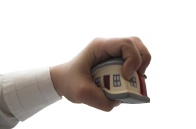Mortgage rates need to rise nearly 6% before house prices begin to slide nationwide, according to new analysis from broker firm Shaw and Partners in the wake of the big bank’s out-of-cycle interest rate hikes.
Amid expectations rivals will follow National Australia Bank (
NAB) and
Westpac’s repricing last week, Shaw and Partners warned clients not to discount chances that higher interest rates could burst a bubble created by the Reserve Bank, which slashed the official cash rate to a record low of 1.5%.
David Spotswood, senior analyst at Shaw and Partners, said it would take the cash rate rising to 3.5%, or real mortgage rates heading to around 5.75%, for house prices to fall across the country.
“This may sound large, but who knew interest rates would get this low,” he said. “We find it continually surprising that people talk of [a] crash in house prices due to supply, fear of lack of Chinese buyers, falling commodity prices, etc. The key drivers of house prices is the availability of finance, the cost of finance, and if you have a job.”
Without any prior warning, NAB lifted variable owner-occupier rates by seven basis points to 5.32% and investor loans 25 basis points to 5.8% last Thursday. Westpac followed suit, jacking up rates more severely for
property investor customers by 23 basis points to 5.79% for principal and interest loans, and 28 basis points to 5.96% for landlords paying off interest costs only.
Sydney-based Westpac also hiked owner-occupier variable rates by between three and eight basis points, giving customers paying both principal and interest a lower rate of 5.32%. Interest-only customers were given a higher rate at 5.49%.
Commonwealth Bank followed suit on Friday (24 March).
As per Shaw’s analysis, borrowers could still access owner-occupied mortgage rates of around 4% after discounts, providing more affordable debt (wherein a $1m loan would cost around $4,000 of interest each month).
Spotswood said house prices were 25% overvalued compared against wages. “Pre-2000, house prices were five times yearly income, now they are eight times. House prices are 60 per cent overvalued versus 2000 on this basis. House prices look like a bubble on this measure,” he said.
He further noted that house prices appeared “well supported” relative to interest rates and could lift further if rates didn’t rise.
The research concluded that the last two times house prices fell nationwide was in 2009 and again in 2012-2014, when debt repayments exceeded 30% of borrowers’ wages. For the bottom to fall out again across the country, “we need a discounted mortgage rate of around 5.75 per cent,” Spotswood said.
Related stories:


